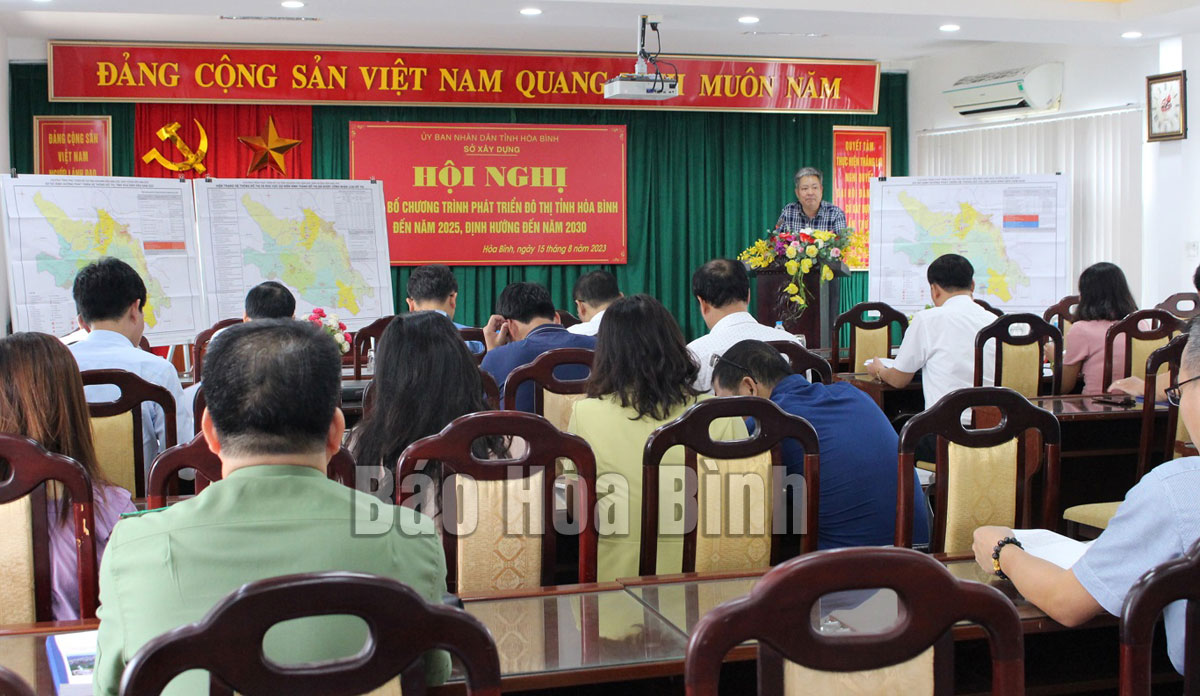
(HBO) – The Hoa Binh provincial Department of Construction held a conference on August 15 to announce the local urban development scheme till 2025, with orientations to 2030
At a conference to announce the provincial administration’s decision approving the local urban development scheme till 2025, with orientations to 2030.
The scheme aims to concretise orientations to urban system development according to the provincial master plan and relevant sectoral ones that have been approved, in line with the national urban development programme. It involves gradually investing in building a comprehensive urban network across the province in phases, adhering to urban development criteria. It also includes creating plans and development paths for the local urban system until 2025, with a vision towards 2030; pooling resources to invest in building and developing the urban system throughout the province, improving the quality and architectural landscape of urban areas in a modern and sophisticated manner, while remaining culturally appropriate for each urban area.
This lays a foundation to set up projects and evaluate the upgrading of urban areas, as well as establish wards and towns in the future. The goal by 2025 is to have 13 urban areas in the entire province, consisting of 10 existing urban areas and three new ones, namly Luong Son district meeting the criteria for a Type IV urban area, and the communes of Phong Phu in Tan Lac district and Nhan Nghia in Lac Son district meeting the criteria for a Type V urban area. The urbanisation rate of the province is targeted at around 39% - 46.16%.
By 2030, the aim is to further increase the number of urban areas to 16. This includes developing two existing urban areas into Type IV ones, namely Chi Ne township in Lac Thuy district and Bo township in Kim Boi district. Additionally, three new urban areas will be developed, including Dung Phong commune in Cao Phong district, An Nghia commune in Lac Son district, and Van Mai commune in Mai Chau district, all meeting the criteria for a Type V urban area. This would raise the urbanisation rate of the province to about 43.19% - 50.57%.
A leader of the department also unveiled specific plans to upgrade the types of existing urban areas, the intended locations for new urban areas, urban development targets by 2025, and a priority investment list for developing the framework infrastructure and key connection points of the urban system across the province.
The estimated capital investment need for urban construction in the province until 2025, with orientations towards 2030, is projected to exceed 138 trillion VND. Of this, the capital for framework infrastructure and key technical infrastructure connecting the urban transportation system is approximately 83.8 billion VND, and that for developing existing urban areas and the expected locations for new urban areas around 54.2 billion VND.
Six solution groups related to capital sources, investment attraction, policies, climate-adaptive urban development, human resources, construction and planning were also outlined.
The Standing Board of the Hoa Binh provincial Party Committee has agreed in principle on a proposal by the Standing Board of the Party Committee of Hoa Binh city to gather feedback on the city’s 1:2000 zoning plan, which forms part of its broader urban development strategy.
Hoa Binh province has made notable progress in public administration reform and digital government development, with the satisfaction index among citizens and businesses reaching over 84%, according to recent government evaluations.
Thanks to great efforts by local authorities in recent times, the governance and public administration performance of Mai Chau district has been significantly improved.
In the afternoon of June 6, the Party Committee, the People's Council, the People's Committee and the Fatherland Front of Lac Son district solemnly held a meeting to celebrate the 139th anniversary of the district's founding (1886–2025) and the 79th anniversary of the establishment of the district's Party Committee (1946–2025). There was the attendance of Mr. Bui Van Thang, the Vice Chairman of the Provincial People's Council; Mr. Quach Tat Liem, the Vice Chairman of the Provincial People's Committee; Ms. Dang Bich Ngoc, the Deputy Head of the National Assembly Delegation of the province; as well as the former leaders of the province and district through various periods, who are the natives of the district.
Implementing the Politburo’s Resolution No. 57-NQ/TW on breakthroughs in science – technology, innovation, and digital transformation is a golden opportunity for the northern mountainous province of Hoa Binh to renew growth model, improve competitive edge and shorten digital gap.
Resolution 57-NQ/TW, issued by the Politburo on December 22, 2024, identifies sci-tech, innovation, and digital transformation as strategic breakthroughs to build a developed and prosperous nation. In Hoa Binh province, this spirit is not just a slogan, it’s being put into action through concrete initiatives that form a "new development triangle”: digital citizenship, digital economy, and digital administration.



